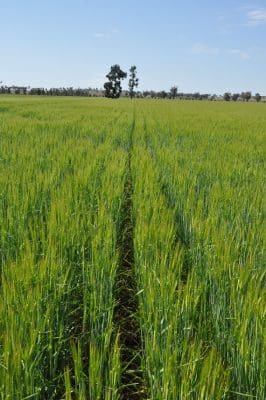CONTINUOUS cropping can be sustained over many decades as long as soil fertility is maintained, weeds are kept under control, and economic risks are managed, according to CSIRO farming systems agronomist, John Kirkegaard.
There has been a growing trend towards more intensified cropping on Australian farms.
In the two decades from the mid-1980s Australia’s crop area doubled and sheep numbers halved with many farms, or parts of farms, becoming continuously cropped.
The practice has placed renewed demands on farmers’ management skills, particularly in relation to soil nutrition and weed and disease pressures.
Speaking at the Grains Research and Development Corporation (GRDC) Research Updates in Corowa and Wagga Wagga, NSW, Dr Kirkegaard said with continuous cropping it was necessary to provide a greater proportion of crop nitrogen (N) as fertiliser, and expend greater resources on maintaining low weed populations.
“As soil N fertility slowly declines under continuous cropping, more fertiliser may be required at sowing to ensure adequate N to achieve highly profitable crop yields,” Dr Kirkegaard said.
“In stubble-retained systems, surface applied N is more prone to immobilisation and the amount that can be drilled with the seed is limited.
“Banding N fertiliser below or beside seed rows at sowing can improve the efficiency of N uptake in crops by making more available to the plant, reducing the competition for N with soil microbes and reducing leaching or denitrification losses prior to plant uptake by slowing the rate of nitrification.
Dr Kirkegaard said incorporating legumes into the crop system was one way of helping to maintain a better organic N balance.
“Legumes frequently fix around 20 kilograms/hectare of N per tonne of shoot biomass grown, but there is enormous variability in fixed and net N inputs of different end-uses, though harvested grain legumes rarely match those achieved by well-managed, legume-based grazed pastures,” he said.
“Incorporating legumes into a farming system also reduces the financial risk associated with large N fertiliser inputs, as no N is applied to the legume and less is usually required for the following cereal crops.”
Dr Kirkegaard said continuous cropping could lead to greater weed, disease and pest pressures such as herbicide resistance and increasing weeds that were favoured by modern, no-till cropping systems.
“Well-managed pasture phases provide excellent opportunities to control most biotic threats to crop production, but a range of integrated weed, pest and disease management approaches are available for application in continuous cropping systems,” he said.
“A diverse cropping sequence – that is, a sequence of different crop species and end-uses – provides the most cost-effective defence against most of these threats.”
Dr Kirkegaard said a key challenge and a major cost to continuous cropping systems that were primarily reliant on herbicides for weed control, was the development of herbicide resistance.
“A diverse cropping sequence – that is, a sequence of different crop species and end-uses – provides the most cost-effective defence against most…threats.”
John Kirkegaard
He said maintaining a diversity of crops, control practices and herbicides was the key to staying ahead of the resistance problem.
“The number of weed individuals to which a given (chemical) mode of action is exposed and how often, determines the speed at which resistance develops,” he said.
“Therefore, development of resistance is slowed by maintaining weed populations at very low levels and preventing seed set in individuals that have survived chemical control.
“Keeping weed populations at very low levels by a variety of complementary practices forms the basis of integrated weed management, which is essential to ensure the sustainability of continuous cropping systems.”
Dr Kirkegaard said the large areas sown under continuous cropping in Australia had contributed to the increasing use of dry seeding which, in the absence of knockdown herbicides, could place increasing reliance on selective herbicides if weed seed banks were not kept low.
Ultimately, he said management skill, rather than enterprise mix, drove the resilience of any farming systems and that sound agronomic and business management were especially required in continuous cropping systems.



HAVE YOUR SAY